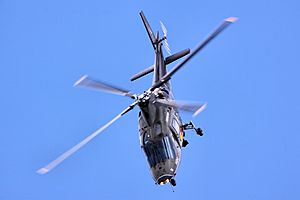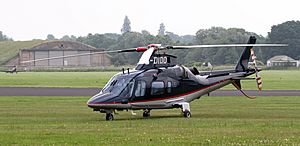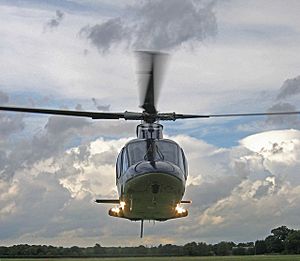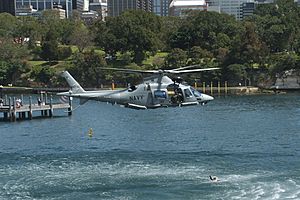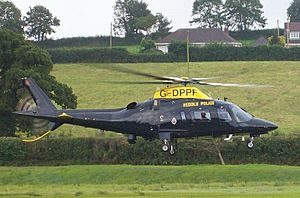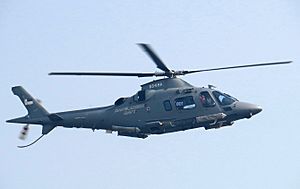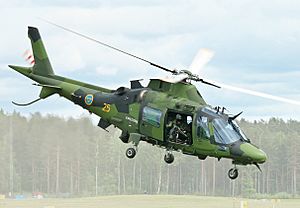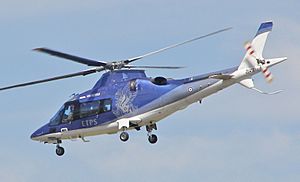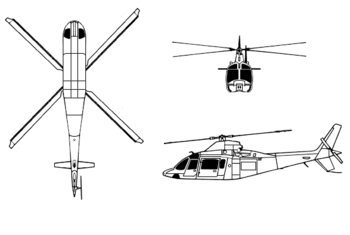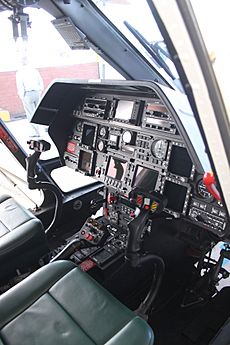AgustaWestland AW109 facts for kids
Quick facts for kids AW109 |
|
|---|---|
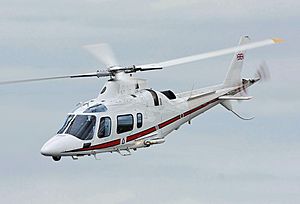 |
|
| An AW109E formerly operated by No. 32 Squadron RAF in 2012 | |
| Role | Search and rescue/utility helicopter |
| Manufacturer | Agusta AgustaWestland Leonardo S.p.A. |
| First flight | 4 August 1971 |
| Introduction | 1976 |
| Status | Active service, in production |
| Primary users | Italian Army Rega (Swiss Air Rescue) South African Air Force Royal New Zealand Air Force Royal Malaysian Air Force |
| Produced | 1971–present |
| Unit cost | US$ 6.3 million |
| Variants | AgustaWestland AW109S Grand |
| Developed into | AgustaWestland AW119 Koala |
The AgustaWestland AW109, originally the Agusta A109, is a lightweight, twin-engine, eight-seat multi-purpose helicopter designed and initially produced by the Italian rotorcraft manufacturer Agusta. It was the first all-Italian helicopter to be mass-produced. Its production has been continued by Agusta's successor companies, presently Leonardo S.p.A. (formerly AgustaWestland, merged into the new Finmeccanica since 2016).
Development of the A109 commenced during the late 1960s as an indigenous rotorcraft suited to commercial operations. A twin-engine arrangement was pursued in response to market interest, while work on the civil model was prioritised over the military-orientated A109B project. On 4 August 1971, the first of three prototypes made its maiden flight. On 1 June 1975, the type received certification from the Federal Aviation Administration (FAA), permitting its service entry in 1976. The A109 has been used in a wide variety of roles, including light utility, VIP transport, aeromedical, law enforcement, search and rescue (SAR), and several military roles. Dedicated military models have been produced for both land and sea operations. Several models with alternative engines, expanded fuselages, and alternative equipment fitouts have been produced. Some AW109s feature a convertible interior to quickly adapt the rotorcraft between roles. Various third party companies also offer adaptions and services for the type.
Following the merger of Agusta and the British company Westland Helicopters to form AgustaWestland, the A109 has been rebranded as the AW109. International involvement in the programme has also been pursued; the company has established final assembly lines at sites in both Italy and the US. Furthermore, hundreds of AW109 fuselages have been manufactured by the Polish aerospace company PZL-Świdnik since the mid-1990s. AgustaWestland formed a joint venture with the Changhe Aircraft Industries Corporation in 2004 that produces and supports the AW109, includes a final assembly line, in China. The AW109 has been in continuous production for 40 years. The AgustaWestland AW119 is a derivative of the AW109, the principal difference being that it is powered by a single engine and has a fixed undercarriage.
Contents
Development
Origins
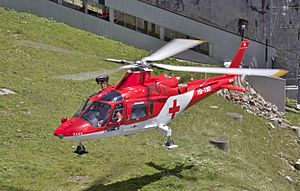
Work on what would become the AW109 commenced during the late 1960s at the Italian helicopter manufacturer Agusta, which sought to design an indigenous rotorcraft suitable for commercial activities. Known as the A109, early designs were of a single-engine helicopter. However, the design team came to recognise that the market found a twin-engine rotorcraft to be more attractive, thus the project was reoriented to fulfil this in 1969, opting to outfit it with a pair of Allison 250-C14 turboshaft engines. While early considerations had been made for a militarised model, which the company internally referred to as the A109B, Agusta intentionally placed a low priority on the work for this variant in favour of other market sectors. In particular, design efforts were concentrated on the eight-seat A109C model.
On 4 August 1971, the first of three prototypes performed the type's maiden flight. The A109 was subject to a protracted flight testing phase, which was largely attributable to the discovery of dynamic instability that took roughly one year to resolve via a modified transmission design. Almost four years later, the first production helicopter was officially completed during April 1975. On 1 June 1975, the type received certification for visual flight rules (VFR) from the Federal Aviation Administration (FAA), permitting the A109 to be operated in North America.
During 1976, deliveries of production A109s commenced to civil customers. The type offered several advantages over the then-market leading Bell 206, including its greater top speed, twin-engine redundancy, and increased seating capacity. In 1975, Agusta's design team revisited the concept of a military version; to support their work, a series of flying trials were carried out between 1976 and 1977 involving a total of five A109As that had been outfitted with Hughes Aircraft-built TOW missiles. From these endeavours, two different military versions of the A109 emerged, one being intended for light attack/close air support missions while the other was optimised for shipboard operations.
Further development
Shortly following after the launch of the initial production model, Agusta begun work on additional models, primarily for the civil sector. During 1981, an A109A Mk2, that featured a widened cabin, was made available to operators. In 1993, the A109 K2 model was introduced, which was powered by alternative engine in the form of the Turbomeca Arriel 1K1. During 1996, the A109 Power was launched, which was broadly similar to the K2 except for the adoption of yet another powerplant, the Pratt & Whitney Canada PW206 engine. By 2008, according to AgustaWestland, the A109 Power was being operated across 46 countries. In 2006, an enlarged variant, the A109S Grand, was introduced.
The A109 was renamed the AW109 as a consequence of the July 2000 merger of Finmeccanica S.p.A. and GKN plc's respective helicopter subsidiaries Agusta and Westland Helicopters to form AgustaWestland. Since the mid-1990s, fuselages for the AW109 have been manufactured by PZL-Świdnik, which became a subsidiary company of AgustaWestland in 2010. In June 2006, the 500th fuselage was delivered by the Polish aerospace company PZL-Świdnik, marking 10 years of co-operation on the AW109 between the two companies. In 2004, AgustaWestland formed a joint venture with the Changhe Aircraft Industries Corporation for the support and production of the AW109 in China; by 2009, the joint venture was reportedly capable of performing the final assembly of the AW109 in addition to independently manufacturing major sections, such as the fuselage.
In February 2014, AgustaWestland announced the development of the AW109 Trekker, an updated model. It is equipped with skid landing gear (being the first twin-engine helicopter produced by the company to have this feature) and is powered by a pair of FADEC-equipped Pratt & Whitney Canada PW207C engines; its avionics are supplied by Genesys Aerospace, which have been designed for single-pilot operations. The Trekker reportedly expands upon the utility capabilities of the standard AW109. Akin to the prior models, the final assembly of the AW109 Trekker is undertaken at sites in both the US and Italy.
Design
The AW109 is a lightweight twin-engine helicopter, known for its speed, elegant appearance and ease of control. Since entering commercial service, several revisions and iterations have been made, frequently introducing new avionics and engine technologies. AgustaWestland have promoted the type for its multirole capabilities and serviceability. The type has proven highly popular with VIP/corporate customers; according to AgustaWestland, 50% of all of the AW109 Power variant had been sold in such configurations. Other roles for the AW109 have included emergency medical services, law enforcement, homeland security missions, harbor pilot shuttle duty, search and rescue, maritime operations, and military uses. In 2008, AgustaWestland claimed the AW109 to be "one of the industry’s best-selling helicopters".
A range of turboshaft powerplants have been used to power the numerous variants of the AW109, from the original Allison 250-C14 engines to the Turbomeca Arriel 1K1 and Pratt & Whitney Canada PW206 of more modern aircraft. Powerplants can be replaced or swapped for during airframe overhauls, resulting in increasing lifting capacity and other performance changes. In the case of single-engine failure, the AW109 is intended to have a generous power reserve even on a single engine. The engines drive a fully articulated four-blade rotor system. Over time, more advanced rotor blade designs have been progressively adopted for the AW109's main and tail rotors, such as composite materials being used to replace bonded metal, these improvements have typically been made with the aim of reducing operating costs and noise signature. According to Rotor&Wing, the type is well regarded for its "high, hot, and heavy" performance.
According to AgustaWestland, the AW109 Power features various advanced avionics systems, these include a three-axis autopilot, an auto-coupled Instrument Landing System, integrated GPS, a Moving Map Display, weather radar, and a Traffic Alerting System. These systems are designed to reduce pilot workload (the AW109 can be flown under single or dual-pilot instrument flight rules (IFR)) and enable the use of night vision goggles (NVG) to conduct day-or-night operations. The AW109 has a forced trim system which can be readily and selectively activated by the controlling pilot using triggers located on the cyclic and collective which hold the control inputs at the last set position if activated. All critical systems are deliberately redundant for fail-safe operations; the hydraulic system, hydraulic actuators, and electrical system are all dual-redundant, while the power inverters are triple-redundant. The AW109 also has reduced maintenance requirements due to an emphasis on reliability across the range of components used.
Some models of the AW109 feature the "quick convertible interior", a cabin configuration designed to be flexibly re-configured to allow the rotorcraft to be quickly adapted for different roles, such as the installation or removal of mission consoles or medical stretchers. Mission-specific equipment can also be installed in the externally accessible separate baggage compartment, which can be optionally expanded. Optional cabin equipment includes soundproofing, air conditioning, and bleed air heating. Aftermarket cabin configurations are offered by third parties; Pininfarina and Versace have both offered designer interiors for the AW109, while Aerolite Max Bucher has developed a lightweight emergency medical service interior. The majority of AW109s are fitted with a retractable wheeled tricycle undercarriage, providing greater comfort than skids and taxiing capability. For shipboard operations, the wheeled landing gear is reinforced, deck mooring points are fixed across the lower fuselage, and extensive corrosion protection is typically applied.
Optional mission equipment for the AW109 has included dual controls, a rotor brake, windshield wipers, a fixed cargo hook, snow skis, external loudspeakers, wire-strike protection system, engine particle separator, engine compartment fire extinguishers, datalink, and rappelling fittings. A range of armaments can be installed upon the AW109, including pintle-mounted machine guns, machine gun pods, 20mm cannons, rocket pods, anti-tank missiles and air-to-air missiles. Those AW109s operated by the U.S. Coast Guard, later designated as MH-68A, had the following equipment installed: a rescue hoist, emergency floats, FLIR, Spectrolab NightSun search light, a 7.62 mm M240D machine gun and a Barrett M107 semi-automatic 12.7 mm (.50 caliber) anti-material rifle with laser sight.
Operational history
Various branches of the Italian military have operated variants of the AW109; the Guardia di Finanza has operated its own variant of the AW109 since the 1980s for border patrol and customs duties, by 2010, it was in the process of replacing its original AW109s with a new-generation of AW109s.
During 1982, the Argentine Army Aviation deployed three A109As to the Falkland Islands during the Falklands War. They operated with the helicopter fleet (9 UH-1H, 2 CH-47C and 2 Pumas) in reconnaissance and liaison roles. One of the helicopters was destroyed on the ground by a British Harrier attack; the others were captured and sent to Europe aboard HMS Fearless. The British Army Air Corps decided to use those helicopters in domestic operations (being flown by 8 Flight AAC to support SAS regiment deployments in the UK), alongside two additional A109 which were purchased later following favorable use of the first two; all were retired in 2009. The improved AW109E and SP – GrandNew versions have also been operated by No. 32 Squadron of the Royal Air Force to transport members of the British Royal Family.
In 1988, 46 A109s were sold to the Belgian Armed Forces; it was later alleged that Agusta had given the Belgian Socialist Party over 50 million Belgian francs as a bribe to secure the sale. The resulting scandal led to the resignation and later conviction of NATO Secretary General Willy Claes. Belgium has operated an A109 aerial display team. In early 2013, a pair of Belgian AW109s were deployed to Sévaré, Mali, to perform medical evacuation mission in support of the French-led Operation Serval. In June 2013, Belgian newspaper La Libre Belgique alleged that several former Belgian military helicopters had been sold via a private company to South Sudan in violation of a European Union embargo on weapons sales.
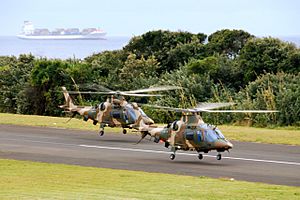
For a number of years, eight armed AW109s, designated MH-68A Sting Ray, were leased from AgustaWestland and deployed at Coast Guard land facilities and onboard cutters. Positive experience with the AW109 led to the Coast Guard deciding to arm all of its helicopters and, following adaptions of their existing assets, the AW109s were returned after the lease expired.
In September 1999, the South African Air Force (SAAF) placed an order for 30 AW109s; 25 of the 30 rotorcraft were assembled locally by Denel Aviation, starting in 2003. As many as 16 SAAF AW109s were deployed for patrol, utility, and medical evacuation missions during the 2010 FIFA World Cup. In July 2013, the SAAF reported that 18 AW109s had effectively been grounded due to lack of funding, these rotorcraft being only occasionally activated but not conducting flights; in 2013, only 71 flight hours were allocated to the whole AW109 fleet. The type may be reduced to flying VIPs rather than being operationally capable; South Africa is also considering selling a number of AW109s, and may cease helicopter operations altogether.
In 2001, 20 AW109s were ordered for the Swedish Armed Forces, receiving the Swedish military designation of Hkp 15. In 2010, it was reported that considerable demands were being placed upon the AW109 fleet, in part due to the delayed delivery of the NHIndustries NH90. In early 2015, a pair of Swedish AW109s were deployed on board the Royal Netherlands Navy ship HNLMS Johan de Witt, their first-ever deployment on board a foreign vessel, in support of a multinational anti-piracy mission off the coast of Somalia; the AW109 reportedly achieve a 100% availability rate over the course of three months.
Between 2007 and 2012, three AW109E Power helicopters were operated under lease by the Royal Australian Navy (RAN) to train naval aircrew.
In May 2008, the Royal New Zealand Air Force (RNZAF) placed an order for five AW109LUH rotorcraft to replace their aging Bell 47 Sioux in a training capacity; they are also used in the utility role to complement the larger NHIndustries NH90 and has seen limited use in VIP missions.
During August 2008, Scott Kasprowicz and Steve Sheik broke the round-the-world speed record using a factory-standard AgustaWestland AW109S Grand, with a time of 11 days, 7 hours and 2 minutes. The AW109S Grand is also recorded as being the fastest helicopter from New York to Los Angeles.
In 2013, the Philippine Air Force (PAF) and the Philippine Navy independently ordered batches of AW109 Power rotorcraft; additional AW109s were ordered in 2014. The PAF AW109s are used as armed gunships, while both armed and unarmed AW109s are operated by the Philippine Navy. During the Battle of Marawi, multiple PAF AW109s engaged in combat the ISIS-affiliated Maute Group. During November 2020, a PAF AW109 was involved in a joint operation of Armed Forces of the Philippines Joint Task Force (JTF) - Sulu against Abu Sayyaf kidnappers in northern Mindanao, firing upon a boat in conjunction with strafing fire from Philippine Navy Multipurpose Assault Craft.
Variants
- A109A
- The first production model, powered by two Allison Model 250-C20 turboshaft engines. It made its first flight on 4 August 1971. Initially, the A109 was marketed under the name of "Hirundo" (Latin for the swallow), but this was dropped within a few years.
- A109A EOA
- Military version for the Italian Army.
- A109A Mk.II
- Upgraded civilian version of the A109A.
- A109A Mk.II MAX
- Aeromedical evacuation version based on A109A Mk.II with extra wide cabin and access doors hinged top and bottom, rather than to one side.
- A109B
- Unbuilt military version.
- A109BA
- Version created for the Belgian Army. Based on the A109C but fitted with fixed landing gear, sliding doors and a tail rotor guard in place of a lower tail fin.
- A109C
- Eight-seat civil version, powered by two Allison Model 250-C20R-1 turboshaft engines.
- A109C MAX
- Aeromedical evacuation version based on A109C with extra-wide cabin and access doors hinged top and bottom, rather than to one side.
- A109D
- One prototype only
- A109E Power
- Upgraded civilian version, initially powered by two Turbomeca Arrius 2K1 engines. Later the manufacturer introduced an option for two Pratt & Whitney PW206C engines to be used – both versions remain known as the A109E. Marketed as the AW109E and Power.
- A109E Power Elite
- A stretched cabin version of A109E Power. Features a glass cockpit with two complete sets of pilot instruments and navigation systems, including a three-axis autopilot, an auto-coupled Instrument Landing System and GPS.
- A109LUH
- Military LUH "Light Utility Helicopter" variant based on the A109E Power. Operators include South African Air Force, Swedish Air Force, Royal New Zealand Air Force, Nigerian Air Force, as well as Algeria and Malaysia. Known as the Hkp15A (utility variant) and 15B (ship-borne search and rescue variant) with the Swedish Air Force.
- MH-68A
- Eight A109E Power aircraft were used by the United States Coast Guard Helicopter Interdiction Tactical Squadron Jacksonville (HITRON Jacksonville) as short-range armed interdiction helicopters from 2000 until 2008, when they were replaced with MH-65C Dolphins. Agusta designated these armed interdiction aircraft as "Mako" until the U.S. Coast Guard officially named it the MH-68A Stingray in 2003.
- A109K
- Military version.
- A109K2
- High-altitude and high-temperature operations with fixed wheels rather than the retractable wheels of most A109 variants. Typically used by police, search and rescue, and air ambulance operators.
- A109M
- Military version.
- A109 km
- Military version for high altitude and high temperature operations.
- A109KN
- Naval version.
- A109CM
- Standard military version.
- A109GdiF
- Version for Guardia di Finanza, the Italian Finance Guard.
- A109S Grand
- Marketed as the AW109 Grand, it is a lengthened cabin-upgraded civilian version with two Pratt & Whitney Canada PW207 engines and lengthened main rotor blades with different tip design from the Power version.
- AW109SP
- AW109 GrandNew
- single pilot IFR, TAWS and EVS, especially for EMS.
- AW109 Trekker
- A variant of the AW109S Grand with fixed landing skids.
- CA109
- Chinese model of the AW109E for China mainland market by Jiangxi Changhe Agusta Helicopter Co., Ltd., a Leonardo Helicopter Division(formerly AgustaWestland) and Changhe Aviation Industries Joint Venture Company established in 2005.
Operators
The AW109 is flown by a range of operators including private companies, military services, emergency services and air charter companies.
Military and government operators
- Gendarmerie Nationale
- Algerian police
- Albanian Air Force
- National Air Force of Angola
- Bangladesh Navy
- Belgian Air Component
- Bulgarian Border Police
- Cameroon Air Force
- Carabineros de Chile
- Bomberos Quito
- Egyptian Air Force
- Hellenic Air Force
- Polizia di Stato
- Carabinieri
- Guardia di Finanza
- Italian Army
- Vigili del Fuoco
- State Forestry Corps
- Tokyo Metropolitan Police
- State Border Guard
- Malaysian Army
- Mexican Air Force
- Royal New Zealand Air Force
- Nigerian Air Force
- Nigerian Navy
- Peruvian Army
- Philippine Air Force
- Philippine Navy
- Slovenian Air Force
- Slovenian Ministry of Defence
- Slovenian Police
- South African Air Force
- Transnet National Ports Authority
- Swedish Armed Forces
- Turkmen Air Force
- Uganda National Police
Former military and government operators
- Argentine Army operated 9 aircraft (1979-2007)
- Royal Australian Navy operated 3 aircraft (2007-2012)
- Italian Air Force operated 3 aircraft
- Paraguayan Air Force
- Air ambulances in Poland
- Army Air Corps
- Venezuelan Army
Accidents
- On 20 November 2009, an AW109E Power of Air ambulances in Poland crashed during landing
- On 16 January 2013: Vauxhall helicopter crash, an AW109 on charter to Rotormotion clipped a construction crane attached to the St George Wharf Tower in Vauxhall, London, before crashing to the ground and bursting into flames, killing the pilot and a person on the ground. The helicopter was completely destroyed and the crane was also seriously damaged.
- On 24 December 2018: in the 2018 Puebla helicopter crash, an AW109 taking off from an airport on the outskirts of Puebla on a flight to Mexico City crashed about 3.5 miles north of the airport. Gov. Martha Erika Alonso and ex-Gov. Rafael Moreno Valle died in this incident.
- On 10 June 2019: in the 2019 New York City helicopter crash, an AW109E crashed at approximately 1:43 p.m. ET on the roof of the AXA Equitable Center at 787 Seventh Avenue in New York City, killing the pilot and creating a fire.
Displayed
- A109A from Corpo Forestale, on display inside Rome's zoo.
- A109A at Fleet Air Arm Museum, Yeovil, England. Former AE-331 of the Argentine Army Aviation, captured in the Falklands War.
Specifications (AW109 Power with PW206C) 2850 Kilo version
Data from ‘’Leonardo’’
General characteristics
- Crew: 1 or 2
- Capacity: 6 or 7 passengers
- Length: 11.448 m (37 ft 7 in) fuselage
- Height: 3.50 m (11 ft 6 in)
- Empty weight: 1,590 kg (3,505 lb)
- Max takeoff weight: 2,850 kg (6,283 lb)
- Powerplant: 2 × Pratt & Whitney Canada PW206C Turboshaft engine, 418 kW (561 hp) each
- Main rotor diameter: 11.00 m (36 ft 1 in)
Performance
- Maximum speed: 311 km/h (193 mph; 168 kn)
- Cruise speed: 285 km/h; 177 mph (154 kn)
- Never exceed speed: 311 km/h; 193 mph (168 kn)
- Ferry range: 932 km (579 mi; 503 nmi)
- Rate of climb: 9.8 m/s (1,930 ft/min)
Notable appearances in media
See also
 In Spanish: AgustaWestland AW109 para niños
In Spanish: AgustaWestland AW109 para niños
- Aircraft related to this one
- AgustaWestland AW109S Grand
- Agusta A129 Mangusta
- AgustaWestland AW119 Koala
- Similar aircraft
- Bell 222/230
- Bell 427
- Bell 429 GlobalRanger
- Bell 430
- Eurocopter AS365 Dauphin
- Eurocopter EC135
- MD Helicopters MD Explorer
- Sikorsky S-76
- HAL Dhruv
- HAL Light Utility Helicopter
- Lists related to this aircraft
- List of rotorcraft


